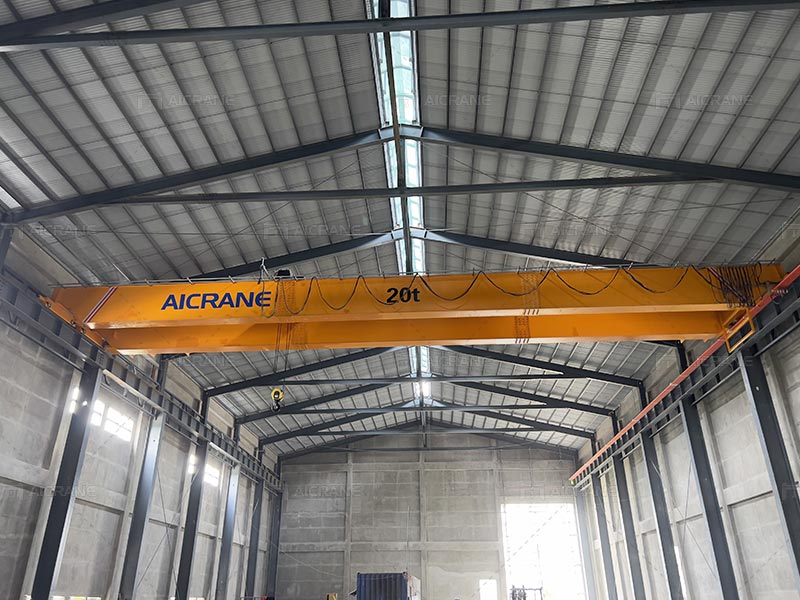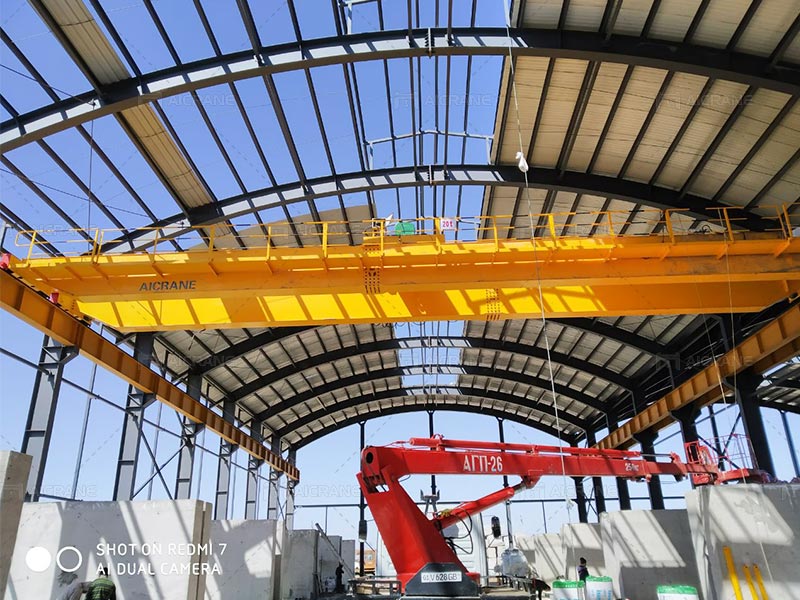Precast concrete handling is a critical aspect of the construction industry, particularly in projects requiring large-scale prefabrication. The efficiency, safety, and precision involved in the handling process directly impact the overall project timeline and quality. Double girder Electric Overhead Traveling (EOT) cranes have emerged as indispensable equipment in this domain, offering unparalleled support in lifting, transporting, and positioning heavy precast concrete components.
In this article, we will explore the role of double girder EOT cranes in precast concrete handling, focusing on their applications, benefits, and the technology behind their effectiveness.

What Are Double Girder EOT Cranes?
Double girder EOT cranes consist of two parallel girders that support a traveling bridge. The hoist, responsible for lifting and lowering loads, moves along these girders. This crane design is known for its high load capacity, making it suitable for heavy-duty applications. The crane operates on an electric motor system, allowing precise control over movements both vertically and horizontally.
Applications in Precast Concrete Handling
- Lifting and Transporting Precast Elements: One of the primary applications of double girder EOT cranes in precast concrete handling is lifting and transporting large and heavy concrete components. Precast elements such as beams, columns, walls, and slabs can weigh several tons, requiring equipment that can handle these loads safely and efficiently. Double girder EOT cranes are designed to manage these weights, ensuring that precast elements are lifted and moved with precision.
- Assembly of Precast Modules: In many construction projects, precast concrete modules need to be assembled on-site. Double girder EOT cranes play a crucial role in this process by enabling the accurate placement of these modules. The crane’s ability to handle large spans and provide fine control over movements ensures that each module is positioned correctly, reducing the risk of misalignment and ensuring structural integrity.
- Loading and Unloading Operations: Precast concrete components are often transported to construction sites from manufacturing plants. Double girder overhead cranes facilitate the loading and unloading of these components from transport vehicles. Their high lifting capacity and reach make them ideal for managing heavy loads in confined spaces, ensuring safe and efficient loading and unloading operations.
- Storage Management: In precast concrete plants, managing storage efficiently is essential to avoid delays and ensure smooth operations. Double girder EOT cranes are used to stack and organize precast components in storage yards. Their ability to lift and move heavy items allows for optimal use of space, keeping the storage area organized and accessible.

Benefits of Using Double Girder EOT Cranes
- High Load Capacity: Double girder EOT cranes are known for their high load capacity, which can range from several tons to hundreds of tons, depending on the design. This makes them suitable for handling the heaviest precast concrete elements, ensuring that even the largest components can be moved safely and efficiently.
- Enhanced Stability: The double girder design provides enhanced stability compared to single girder cranes. This stability is crucial when handling precast concrete, as it minimizes the risk of sway or tilt during lifting and transportation. The stability also contributes to the crane’s ability to handle longer spans, making it suitable for large construction sites.
- Precision and Control: Double girder EOT cranes are equipped with advanced control systems that allow for precise movements. This precision is essential when positioning precast concrete elements, as even a small misalignment can lead to structural issues. The crane’s control system enables operators to make fine adjustments, ensuring that each component is placed exactly where it is needed.
- Durability and Reliability: Constructed with high-quality materials, double girder EOT cranes are built to withstand the demanding conditions of construction sites. Their durability ensures long service life, while their reliability minimizes downtime, contributing to the overall efficiency of precast concrete handling operations.
- Customization Options: Double girder EOT cranes can be customized to meet the specific needs of a project. This includes options such as different lifting capacities, spans, and control systems. Customization ensures that the crane is perfectly suited to the unique requirements of the precast concrete handling process, further enhancing efficiency and safety.
Technological Advancements in Double Girder EOT Cranes
- Anti-Sway Technology: One of the latest advancements in Aicrane overhead cranes is the integration of anti-sway technology. This technology uses sensors and control algorithms to minimize the sway of the load during lifting and transportation. This is particularly important in precast concrete handling, where even minor sway can lead to misalignment or damage to the components.
- Automated Systems: Automation is becoming increasingly prevalent in the construction industry, and double girder EOT cranes are no exception. Automated systems allow for pre-programmed movements, reducing the need for manual control and increasing efficiency. In precast concrete handling, automation can streamline repetitive tasks such as stacking or loading, freeing up operators to focus on more complex activities.
- Remote Monitoring and Diagnostics: Modern double girder EOT cranes are equipped with remote monitoring and diagnostic systems. These systems allow operators and maintenance teams to monitor the crane’s performance in real-time, identifying any potential issues before they lead to downtime. In the context of precast concrete handling, this technology ensures that the crane is always operating at peak efficiency, minimizing delays and disruptions.
- Energy Efficiency: Energy efficiency is a growing concern in the construction industry, and double girder EOT cranes have seen improvements in this area. Advanced motor systems and regenerative braking technologies have been developed to reduce energy consumption, making these cranes more environmentally friendly and cost-effective to operate.
Conclusion
Double girder EOT cranes play a vital role in the handling of precast concrete, offering the strength, stability, and precision required to manage heavy and complex components. Their applications in lifting, transporting, assembling, loading, and storing precast elements make them indispensable in the construction industry. With the ongoing advancements in technology, these cranes continue to evolve, offering even greater efficiency, safety, and reliability.
For any construction project involving precast concrete, the inclusion of a double girder EOT crane can significantly enhance the handling process, contributing to the overall success of the project. Whether dealing with large-scale infrastructure or intricate architectural designs, these cranes provide the essential support needed to manage precast concrete with precision and confidence.